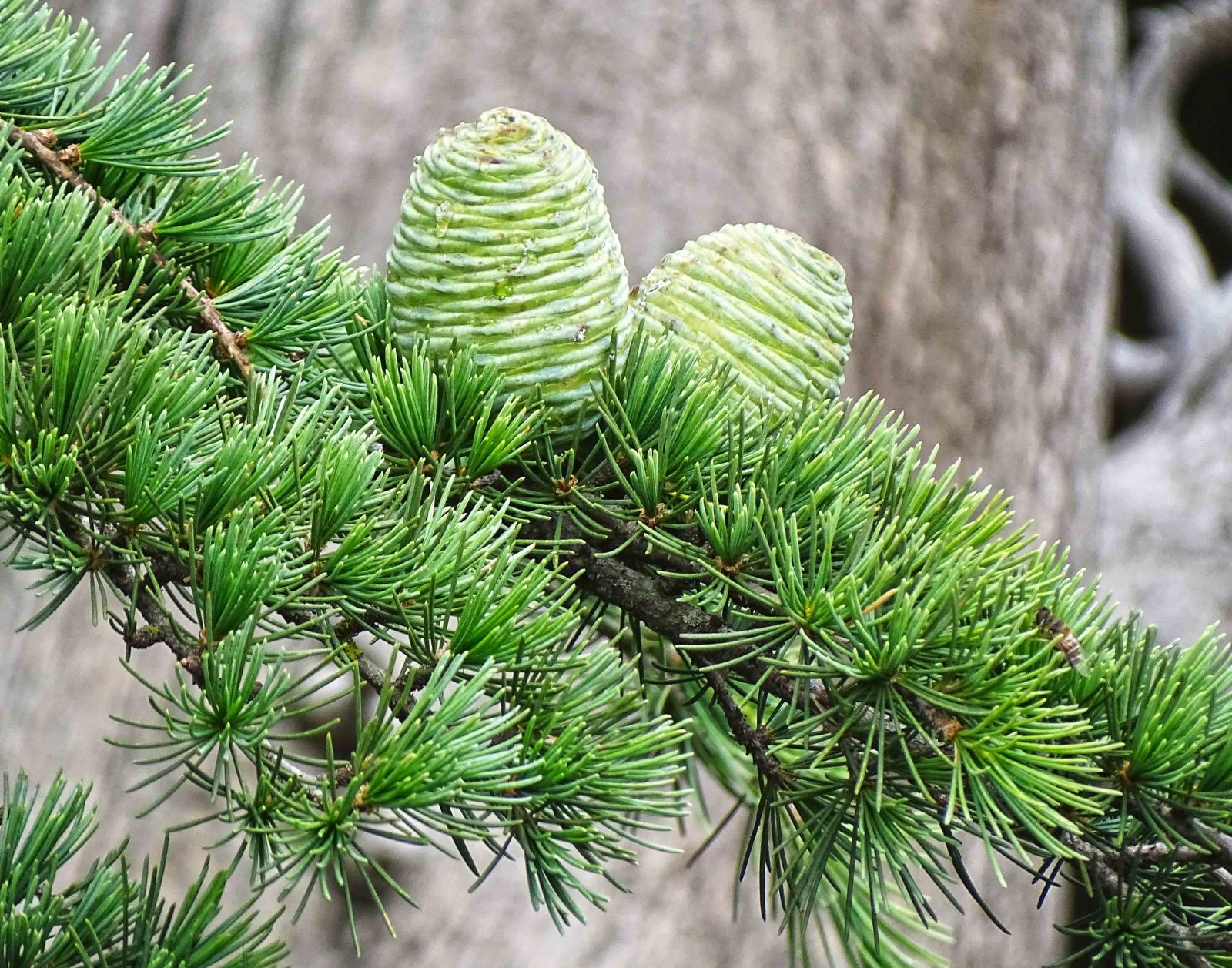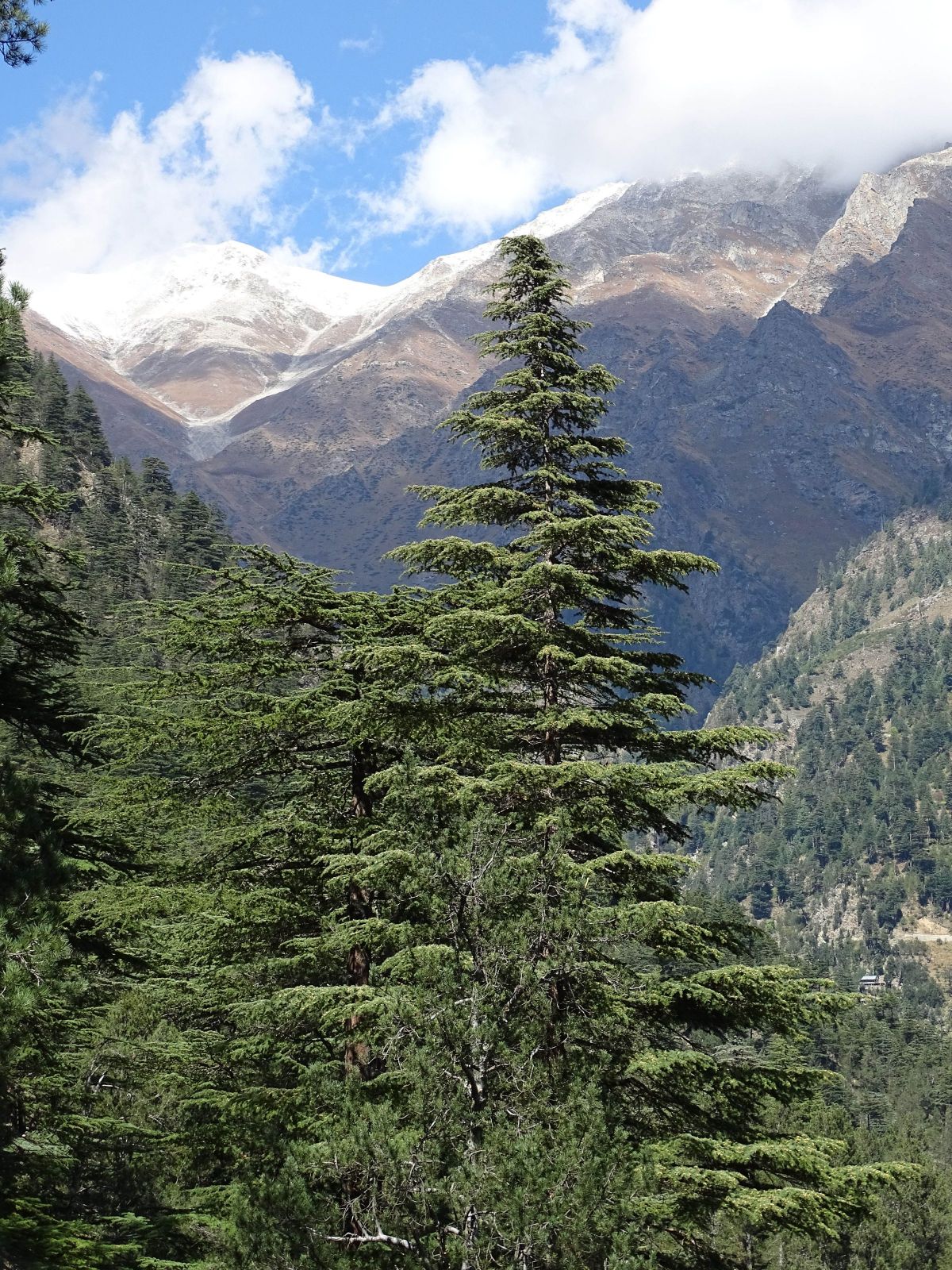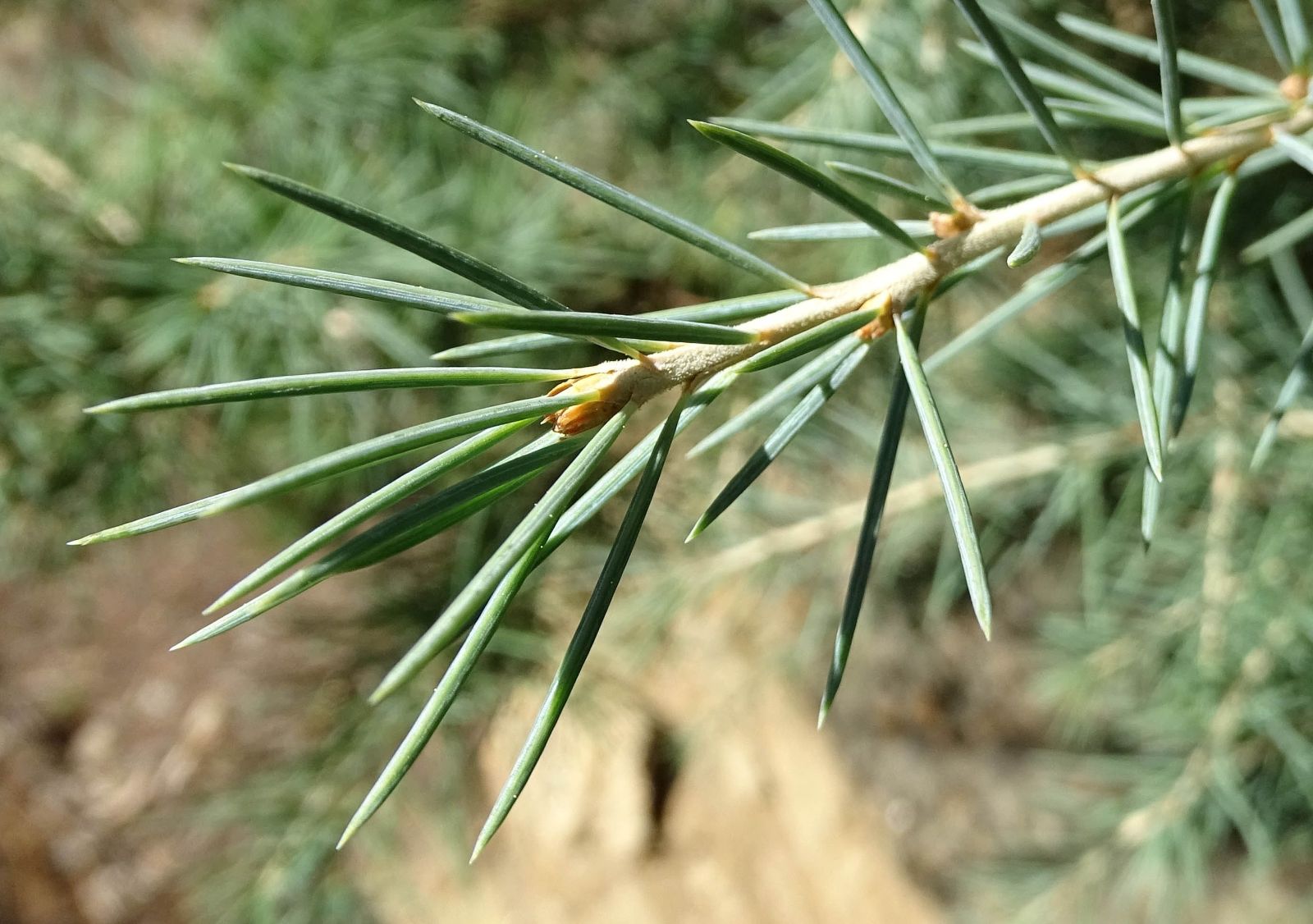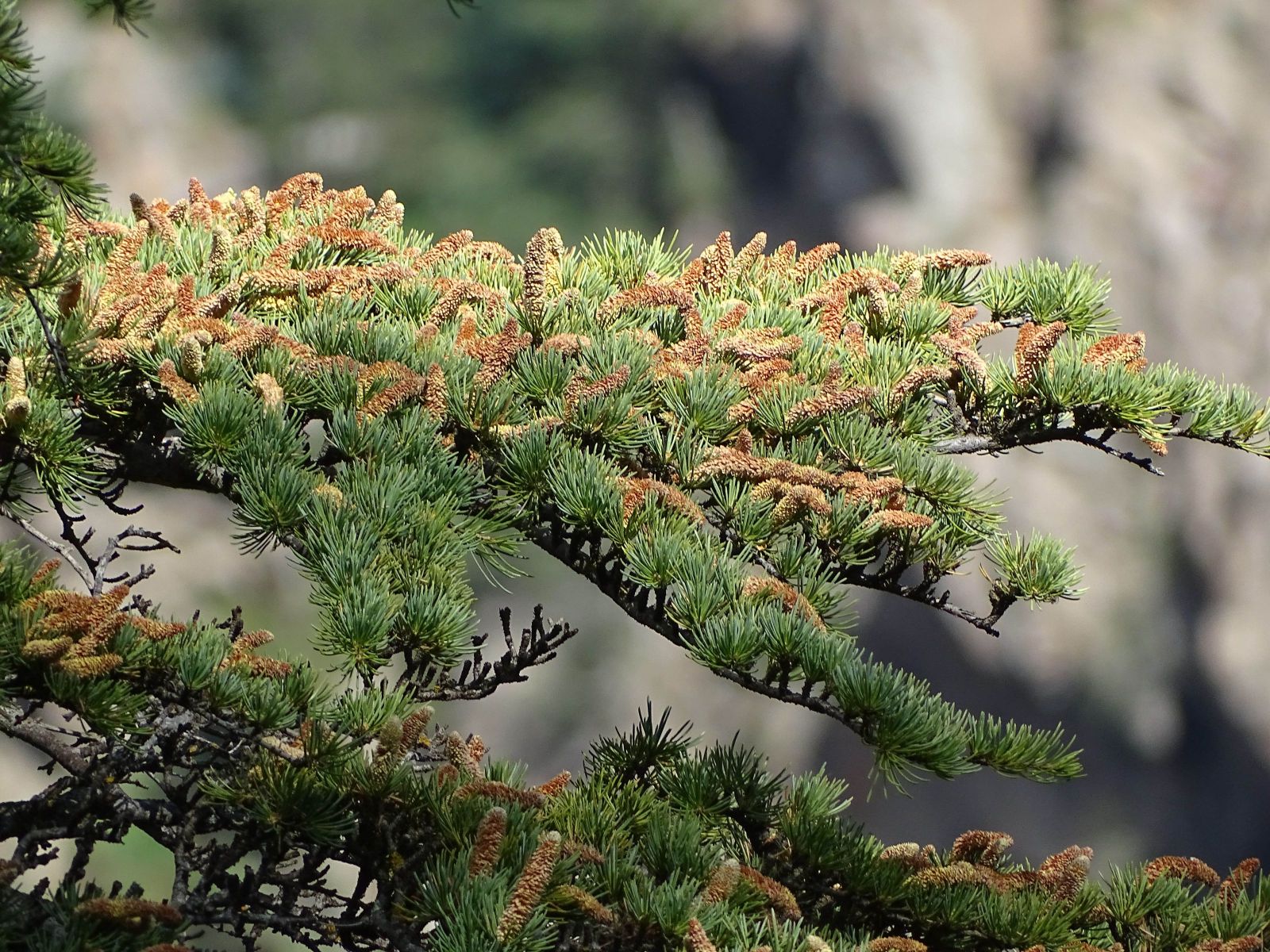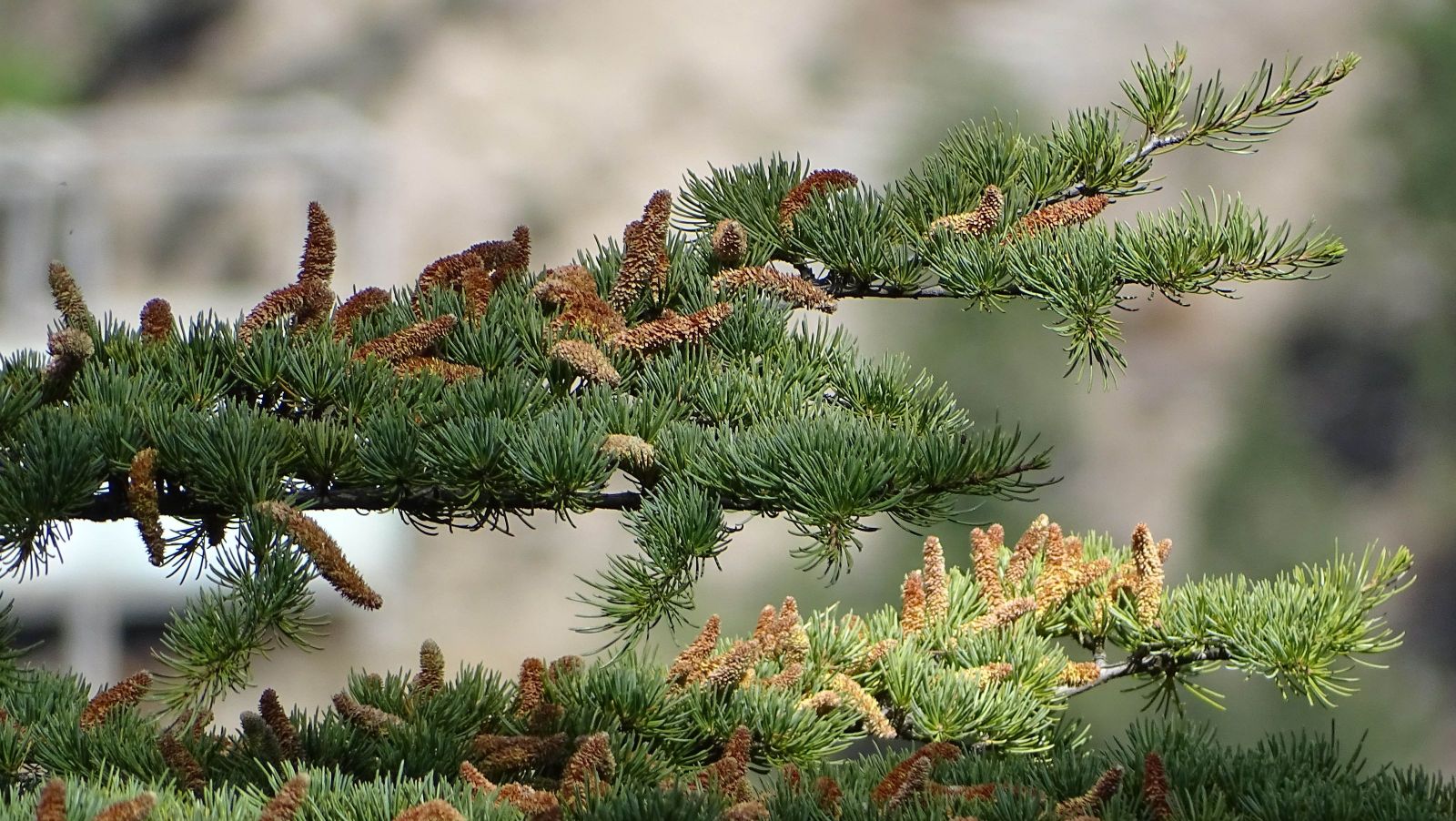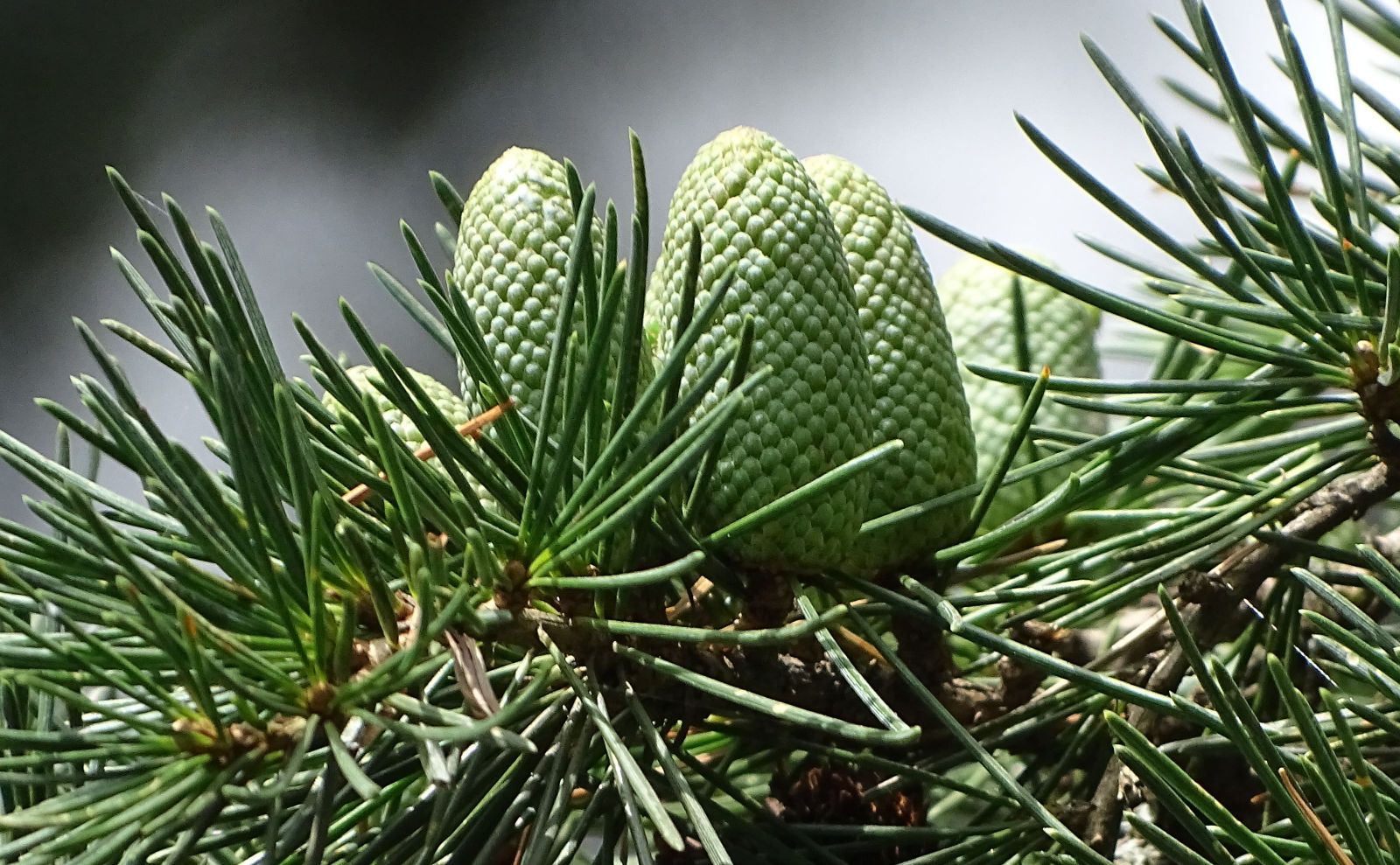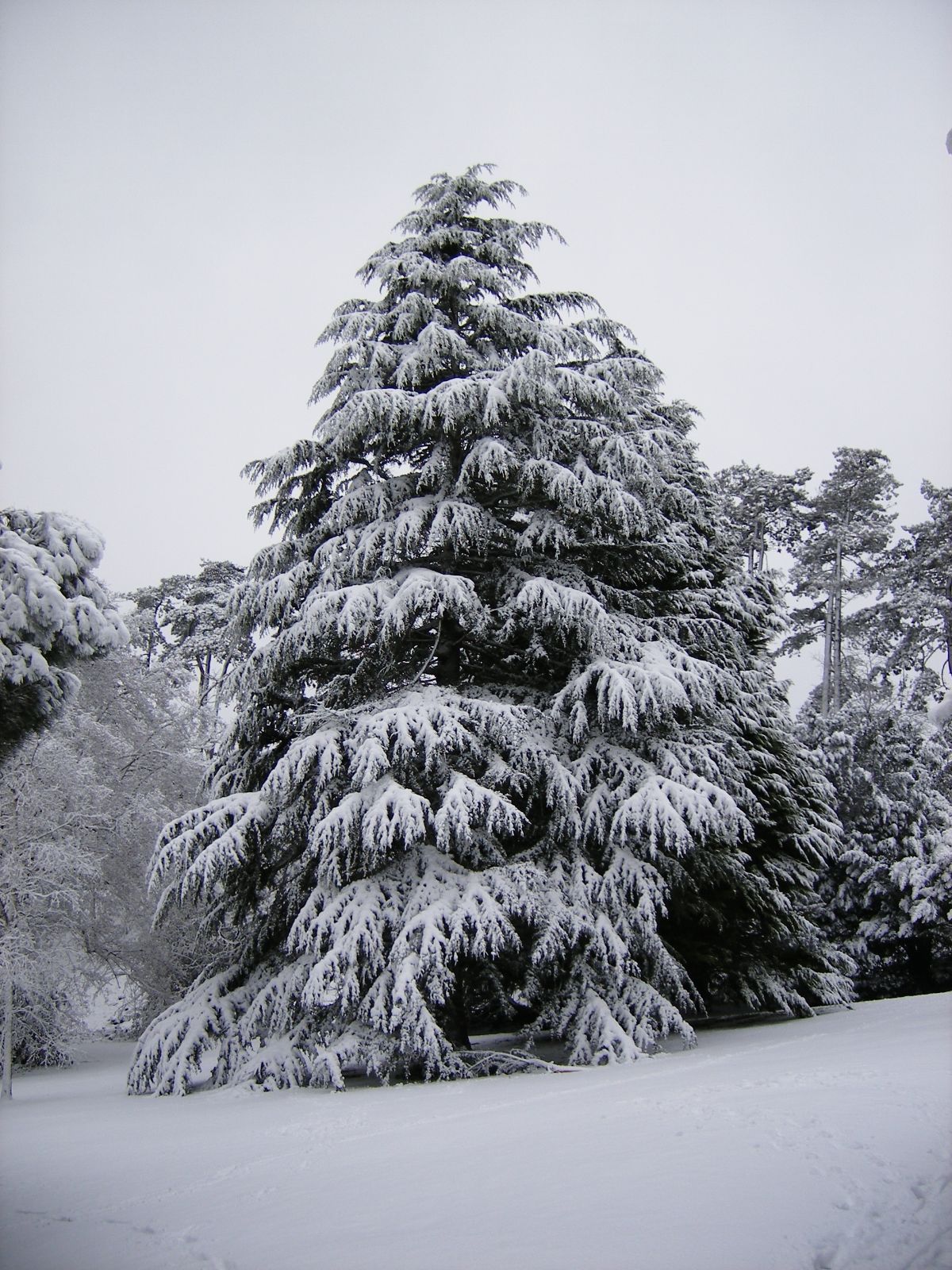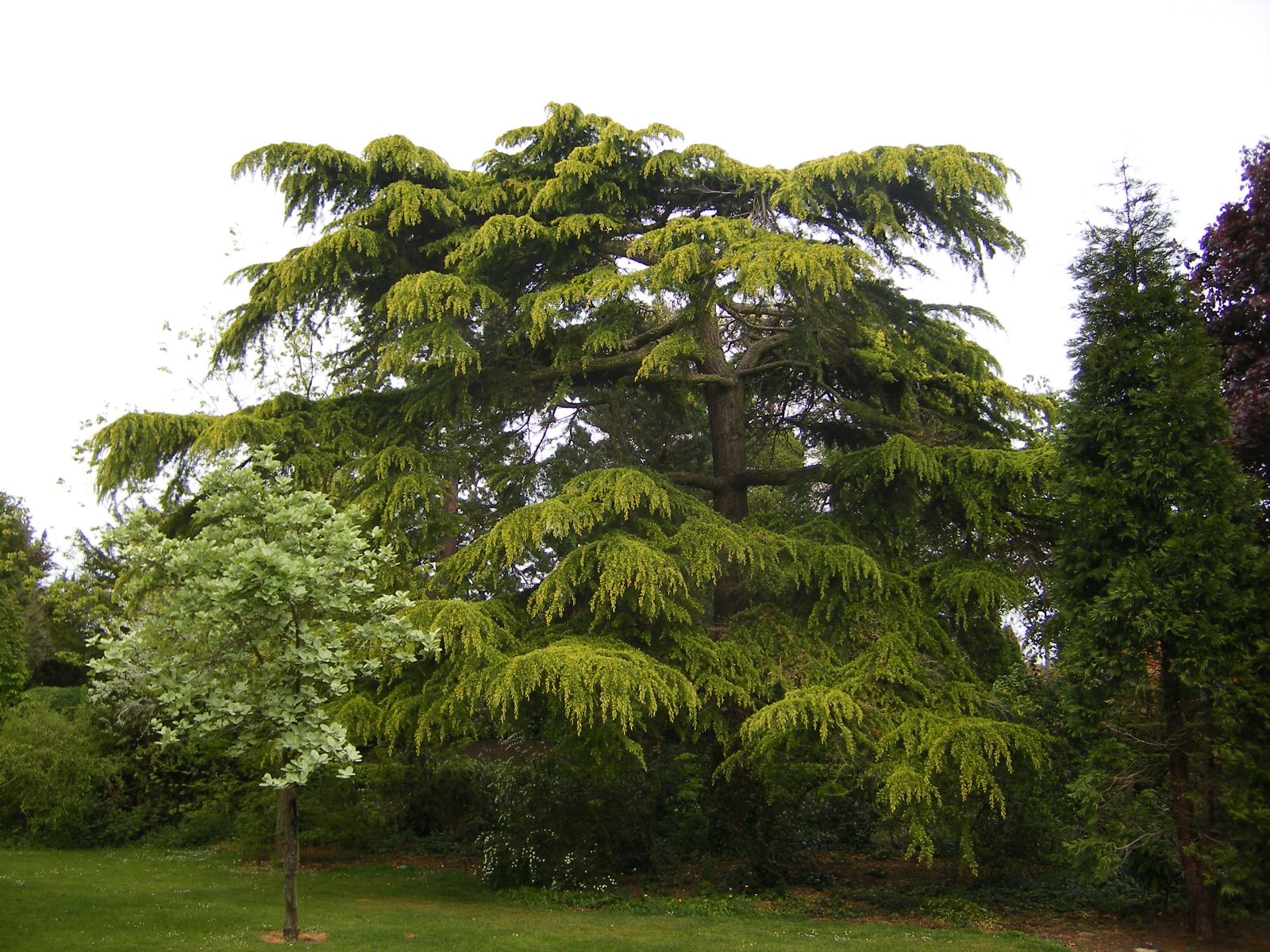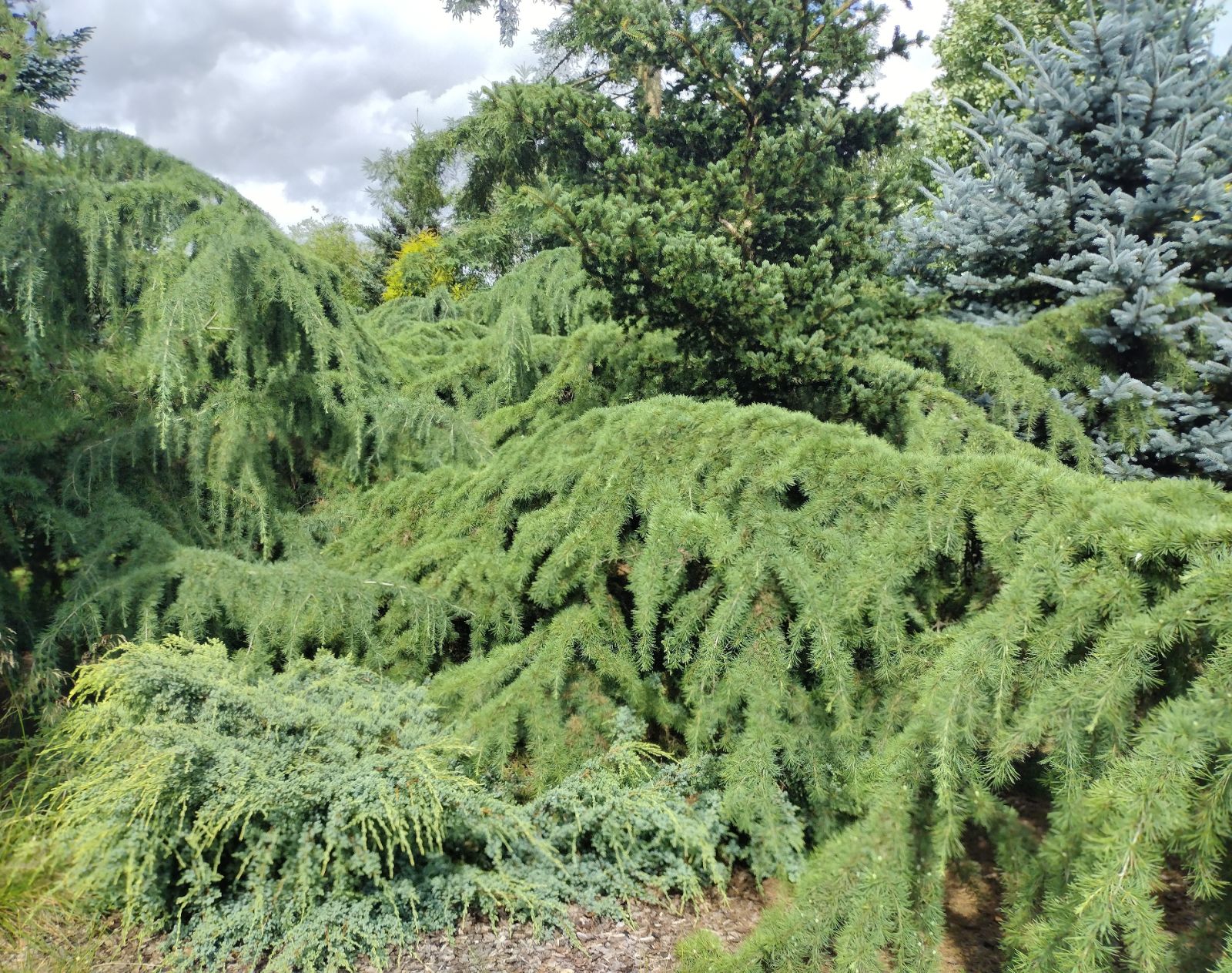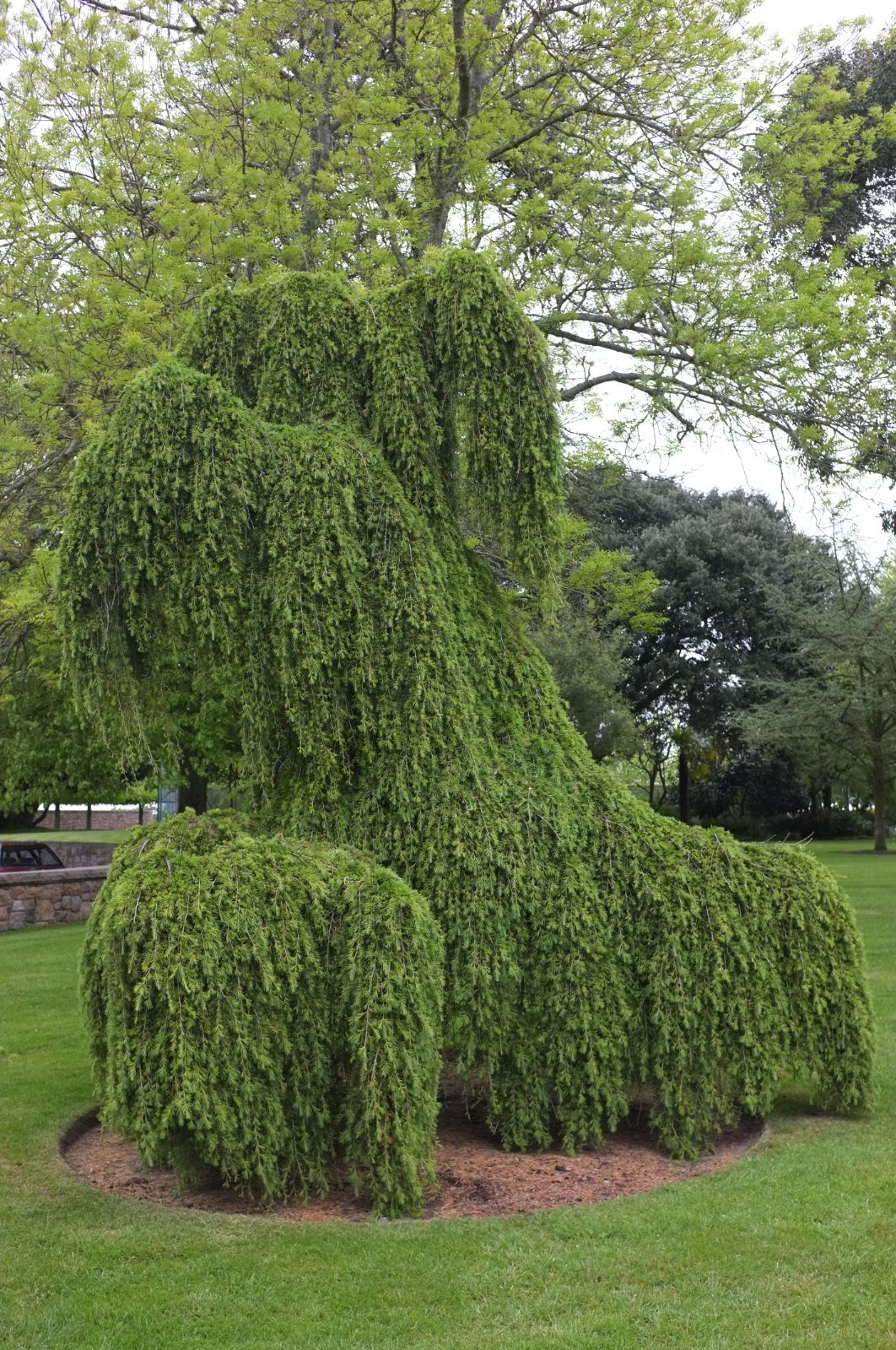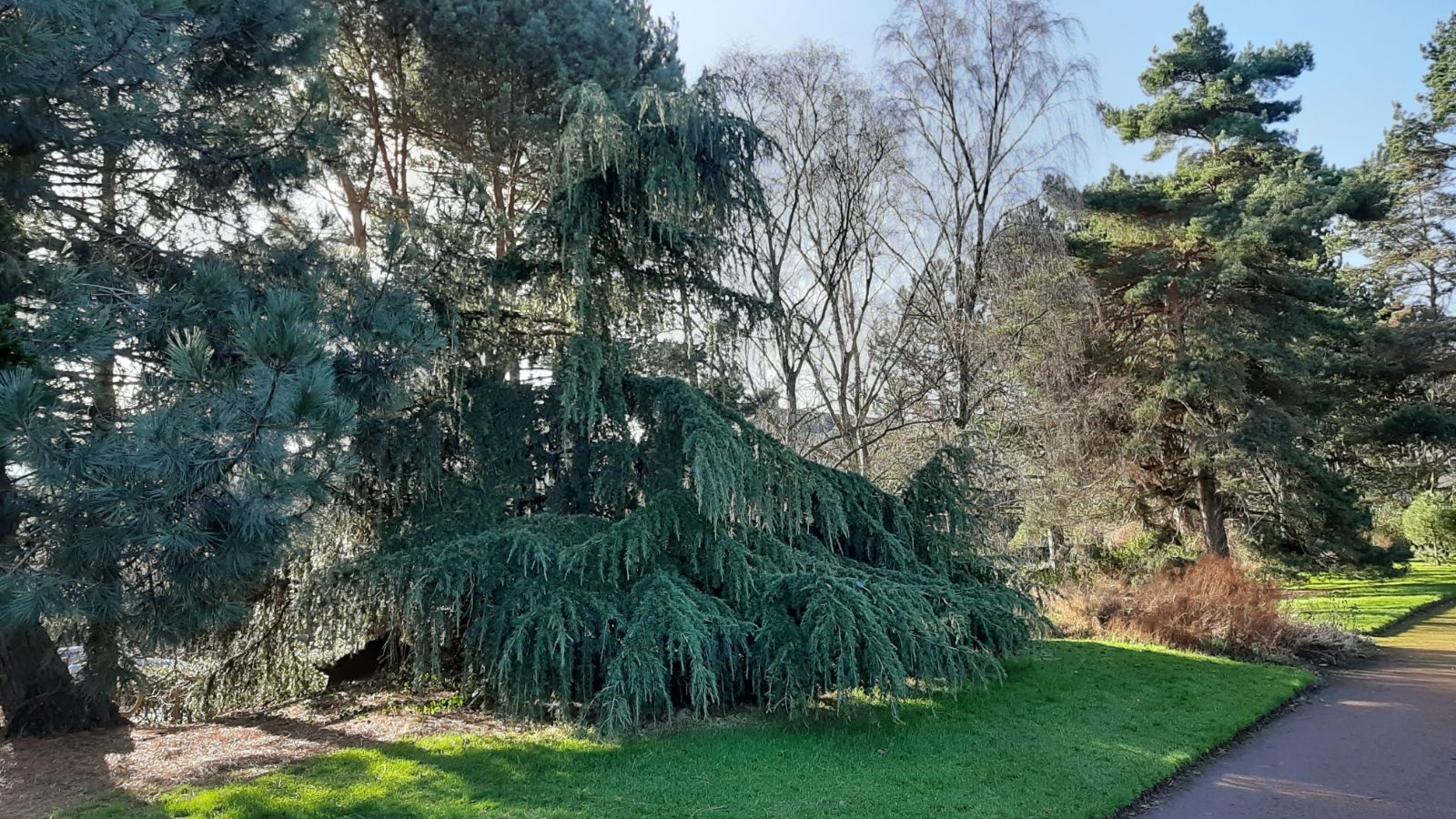Cedrus deodara
Sponsor
Kindly sponsored by
a member of the International Dendrology Society
Credits
Tom Christian (2020)
Recommended citation
Christian, T. (2020), 'Cedrus deodara' from the website Trees and Shrubs Online (treesandshrubsonline.
Genus
Common Names
- Deodar
- Himalayan Cedar
- Cèdre de l'Himalaya
- California Christmas Tree
Synonyms
- Pinus deodara Roxb.
Infraspecifics
- 'Albospica'
- 'Anny's Dwarf'
- 'Argentea'
- 'Aurea'
- 'Bergman's Golden Prostrate'
- 'Bewley's Variegated'
- 'Bill's Blue'
- 'Blue Ball'
- 'Blue Dwarf'
- 'Blue Mountain Broom'
- 'Blue Snake'
- 'Bonte Sport'
- 'Bracken's Best'
- 'Bush's Electra'
- 'Clarke'
- 'Compacta'
- 'Cream Puff'
- 'Crystal Falls'
- 'Deep Cove'
- 'Descanso Dwarf'
- 'Devinely Blue'
- 'Emerald Falls'
- 'Emerald Spreader'
- 'Erecta'
- 'Fallout'
- 'Fastigiata'
- 'Feelin' Blue'
- 'First Snow'
- 'Girard's Weeper'
- 'Glacier Blue'
- 'Glauca'
- 'Glauca Pendula'
- 'Gold Cascade'
- 'Gold Cone'
- 'Gold Gowa'
- 'Gold Mound'
- 'Gold Nugget'
- 'Gold Rush'
- 'Gold Strike'
- 'Golden Horizon'
- 'Grester'
- 'Harvest Gold'
- 'Hesse'
- 'Hibernal'
- 'Hollandia'
- 'Kashmir'
- 'Kelly's Gold'
- 'Kingsville'
- 'Klondyke'
- 'Lakeview'
- 'Lime Glow'
- 'Limelight'
- 'Lohbrunner's Weeper'
- 'Miles High'
- 'Montrose Veil'
- 'Mount Buffalo'
- 'Mountain Beauty'
- 'Mylor'
- 'Nana Aurea'
- 'Nivea'
- Paktia Group
- Paktia Group 'Eisregen'
- Paktia Group 'Eiswinter'
- Paktia Group 'Karl Fuchs'
- Paktia Group 'Polarwinter'
- 'Pendula'
- 'Prostrata'
- 'Prostrate Beauty'
- 'Pygmy'
- 'Raywood's Contorted'
- 'Raywood's Prostrate Dwarf'
- 'Repandens'
- 'Robusta'
- 'Robusta Green'
- 'Roman Gold'
- 'Sampson'
- 'Sander's Blue'
- 'Scott'
- 'Shalimar'
- 'Sharp's Golden Weeping'
- 'Silver Mist'
- 'Silver Spring'
- 'Snow Sprite'
- 'Tristis'
- 'Turtleback'
- 'Twisted Weeper'
- 'Uwe'
- 'Vaneta'
- 'Variegata'
- 'Verticillata'
- 'Verticillata Glauca'
- 'Victoria'
- 'Vink's Golden'
- 'Viridis'
- 'Warrakilla'
- 'Waverly Ridge'
- 'Wells Golden'
- 'White Imp'
- 'Wiesemannii'
Other taxa in genus
Tree typically 40–50 m tall, 2.5–3.5 m dbh, exceptional examples occasionally larger, to 65 m × 4.5 m. Trunk usually monopodial, terete, sometimes forked with multiple co-dominant trunks forming in the upper half. Primary branches massive, spreading horizontally or ascendant in the upper crown, secondary branches spreading in horizontally or descending planes. Leading shoots, including the apical leader, distinctly drooping or pendulous. Habit more strongly upright than in other species. Crown broad-conical in young trees, later pyramidal with the lower third to half of the stem clean of branches in forest settings, branched nearly to the ground in isolated trees. Bark of young trees grey, smooth, soon cracking into small dark-grey plates, on old trees rough, fissured in to small dark grey-brown to blackish-brown plates. Branchlets of two types: short (older growth) and long (young extension growth): short shoots stout, of variable length, assurgent or erect, scaly, grey-brown; long shoots slender, initially smooth then shallowly grooved with green bark in fissures, pale pinkish- or yellow-brown, soon turning grey, with prominent pulvini, densely covered in pale brown pubescence at first. Needles on long shoots spirally arranged, solitary close to the base of long shoots, but more crowded near their tips; on short shoots arranged in false whorls, of 20–30 per whorl, (2.5–)3–4.5(–5) cm (to 6 cm on long shoots) × 1–1.5 mm, linear, slender, quadrangular, apex acute, stomata on all sides but concentrated on two adjacent sides. Pollen cones terminal on short shoots, (4–)5–7 cm long, falling after shedding pollen in autumn, greenish at first, then yellow, then pinkish-brown. Female cones developing terminally on short shoots, maturing when these shoots become woody in their second or third year. Erect, sessile or sub-sessile, 7–11(–13) × 5–7(–9) cm, ovoid or barrel shaped, initially pale grey-green, maturing to glaucous-green, sometimes tinged purple. Rachis persistent, narrowly conical, brown. (Farjon 1990, Debreczy & Rácz 2011).
Distribution Afghanistan Hindu Kush India Kashmir and Gharwal Himalaya Nepal Extreme western Nepal (localised) Pakistan Karakoram
Habitat Montane subtropical forest from 1200 m asl, extending through the temperate mixed-broadleaf and coniferous forests to 3500 m asl in both dry and wet monsoon climates.
USDA Hardiness Zone 5-7
RHS Hardiness Rating H5
Awards AGM
Conservation status Least concern (LC)
In the high valleys of the western Himalaya, in extreme western Nepal, northwest India, north Pakistan, and southeast Afghanistan, grows arguably the most beautiful of all the Cedars, the Deodar. The extraordinary cultural significance and symbology of the Cedar of Lebanon is mirrored 3,000 km to the east in these mountains, where these trees and the forests they form have long been held sacred. Their indigenous name is devadāru, a Sanskrit word meaning ‘wood of the gods’, which appears frequently in ancient Hindu texts just as the Cedars of Lebanon are referred to extensively in the texts of the Abrahamic religions.
Deodar can form pure forests but is more commonly seen growing in association with other tree species. It is the only member of the genus whose distribution extends into the subtropical climatic zone, occurring as it does as a component of lush subtropical forests at its lower altitudinal limit of c. 1,200 m asl. As it ascends the mountains it may be seen associating with various Quercus species, as well as Aesculus indica, Betula utilis and Corylus jacquemontii. These mixed forests soon begin to incorporate other conifers including Picea smithiana, Pinus wallichiana, Cupressus torulosa and Abies pindrow (replaced by Abies spectabilis in the easternmost parts of Deodar’s range) while at its altitudinal limit its only coniferous associate is Juniperus squamata, though there are other montane shrubs including Berberis and Rhododendron spp. Deodar grows in both dry and wet monsoon zones and this variation, together with its large altitudinal range, may be one reason that many early introductions were found to be less hardy, or at least more fickle than the species of the Mediterranean basin, in cultivation in the cool-temperate zones (Farjon 1990; Debreczy & Rácz 2011).
In keeping with the other species in the genus uncertainty surrounds the precise date of Deodar’s introduction to cultivation to the United Kingdom. Loudon (1838) gave the date 1822, but it is more generally accepted that it arrived in 1831, when ‘the Hon. Leslie Melville sent seeds…which were sown at Melville in Fifeshire, at Dropmore, and elsewhere’ (Elwes & Henry 1906). It is probable that Loudon’s 1822 claim referred to a small consignment that was perhaps not successful in establishing the species in cultivation, or else was so small that it quickly retreated into obscurity following the 1831 introduction. Either way, the details appear to have been lost.
Alan Mitchell states that many seedlings raised from the 1831 introduction were distributed by the Horticultural Society and that by the end of the 20th century a scattering of trees of this vintage were still extant in British collections, for example at Dropmore, Buckinghamshire, and at Walcot Park, Shropshire (Mitchell 1996). It would appear from Elwes & Henry (1906) that many early plantings suffered high and early mortality rates, usually once trees had reached 40–50 years of age, which must have been deeply frustrating to gardener, forester and landowner alike, particularly as the Deodar had come to be favoured for ornamental plantings, including as a subject for avenues, by the late 19th century. Its use in such environments followed new introductions of significant quantity through the 1840s and especially the 1850s. In 1856–1857 over 100,000 seedlings were distributed to trials in Britain’s New, Dean and Delamere forests (Elwes & Henry 1906).
In its native habitat Deodar is probably the single most important timber tree and has been utilised as such for thousands of years – again there are parallels with the Cedars of the Mediterranean basin – and in Himachal Pradesh it is grown on a 120-year rotation (RYAN 1999). Following the early experiments in British forestry it was soon eschewed here in favour of more reliably monopodial species such as Pseudotsuga menziesii and Picea sitchensis. This did nothing to dent the enthusiasm for planting Deodar as an ornamental – a use for which it is ideally suited – and on the back of the Victorian conifer craze it became enormously popular in Britain, planted widely as specimen trees in gardens, parks and arboreta, as components of screens and belts around properties where privacy was desired, as well as in avenues and even parkland. Its extensive use in boundary planting around larger properties close to towns, which have long since been engulfed by urban expansion, are one reason Deodar remains such a common sight in large towns and cities – its tolerance of air pollution is another (Mitchell 1996).
Besides its great popularity in Victorian Britain, Deodar was similarly well received in much of continental Europe and in North America, albeit its use in these regions was somewhat limited by its more variable cold-hardiness compared with the other species. Nevertheless it was widely grown in appropriate areas and it was a common ornamental in various parts of the United States by the 1850s. Indeed, it grew so well in the Pacific coast states that it soon earned itself a new vernacular name: ‘the California Christmas tree’ (Jacobson 1996). It is still grown for the Christmas tree trade on the west coast but nowadays faces stiff competition from other species. Mature examples here include two 29 m tall trees growing in the grounds of the California State Capitol Museum, Sacramento (monumentaltrees.com).
Examples of significant size may be found in a broad range of countries. One in France, growing in the Parc Pommé, Oloron, Pyrénées Atlantique, was 41 m tall and 1.68 m dbh when measured in 2019. Two others here were 39 and 37.5 m tall. Others comfortably exceeding 30 m height can be found in Spain, Portugal, Italy, Belgium and Ireland (monumnetaltrees.com) and others are doubtless growing in collections in appropriate climatic zones around the world – Jacobson lists a 34 m example growing in central Otago, New Zealand (Jacobson 1996). Italy is home to several trees with staggering girths, the following measurements all dating from 2017: 2.46 m dbh at the Villa Sommi, Picenardi, Lombardy; 2.43 m dbh at the Villa Meli Lupi, Vigatto, Emilia-Romagna; 2.41 m dbh at the Palazzo Bolongora, Stresa, Piedmont (monumentaltrees.com).
Deodar’s ubiquity also means that some examples notable for their size are to be found in unlikely situations. This is true of one of the tallest in Britain, a 39 m tree (in 2017) growing on steep ground in the car park of the Royal Oak pub in Betwys y Coed, Wales. As with most conifers Deodar is at home on steep slopes and this isn’t demonstrated anywhere better than in its native range where, naturally, the largest examples may be found. Deodar is the tallest growing of all the Cedrus species, reaching upwards of 60 m in parts of its native range (Debreczy & Rácz 2011), and in 2011 an individual with a dbh of 4.6 m was recorded near Tolma in Uttarakhand, India (monumentaltrees.com).
Because the Deodar has such a large east–west range, incorporating both wet and dry monsoon zones, together with a large altitudinal range, provenance can have a significant bearing on its success in cultivation. It is likely that many of the sobering losses reported in Victorian Britain were due, at least in part, to material being sourced from too low down, or too far east. Even in the mountains of northwest India, toward the eastern limit of the species’s range, the topgraphy allows for large volumes of warm air from the lowlands to influence the climate at high altitudes. This influence is far more limited in the west of the species’s range, in Afghanistan and Pakistan, and it is here where the most cold-hardy forms of Deodar occur. This has led to horticulturists seeking out material from the western part of Deodar’s range to increase the range of clones suited to demanding continental climates in North America and in central Europe and Scandinavia. Similarly, ecotypes from the warmer, more humid east, at lower altitudes in northwest India for example, are popular among nurseries in humid warm-temperate regions, for example in northeast Argentina and Uruguay. (Knap 2003).
This large geographic, topographic and climatic range may be one reason that Deodar has yielded so many cultivars. Over 100 have been named, from a plethora of irritatingly similar witch’s brooms to some remarkably useful, good horticultural selections. Growers in more continental climates are indebted, for example, to the efforts of Günther Horstmann who raised the incredibly cold-hardy Paktia Group clones in Germany during the 1970s, while the clone ‘Robusta’ is popular in warm-temperate regions, but not a plant for a continental winter. There are large numbers of yellow or gold-needled selections, some retaining their colouration year round, others having the decency to edge back toward a more respectable green through the winter months. William Goddard of Floravista Gardens, British Columbia, Canada, raised and introduced a large number of Deodar cultivars through the 1970s and 1980s, between them incorporating just about every variable possible, from ultimate size, to habit, to needle colouration (seasonal or constant), variegation, and vigour. New cultivars appear regularly, for example ‘Grester’ (Sterling Frost™), which was raised in the United States and marks an important expansion in the range of blues available in this species. (Auders & Spicer 2012; Hatch 2018–2020).
'Albospica'
Ultimately a medium-sized tree of broad-pyramidal habit. The tips of young shoots are creamy white, maturing yellowish, eventually turning green. To 3 × 2 m in ten years. Less hardy than the species, according to Auders & Spicer (2012). Offered by R. Smith, England, in 1867, and in commerce in California by 1888. It has become very rare in European collections but was offered by several west-coast US nurseries in the late 1980s and early 1990s. (Jacobson 1996; Auders & Spicer 2012).
'Anny's Dwarf'
A dwarf form, wide-spreading with yellow-green foliage. To 50 cm tall in ten years but much wider. Propagated from a witch’s broom by André van Nijnatten in the Netherlands, before 2005. (Auders & Spicer 2012).
'Argentea'
Common Names
Silver Deodar Cedar
Synonyms / alternative names
Cedrus deodara 'Silver' (?)
A fast-growing selection with particularly long silver-grey-green needles, first described in 1866 from a tree cultivated in France. A very similar clone, often sold as ‘Silver’ in North America, may be no more than a renaming of ‘Argentea’ but this cannot be proven. (Auders & Spicer 2012; Hatch 2018–2020).
'Aurea'
A vigorous, fast-growing tree in its youth, eventually forming a broadly pyramidal or conical tree. The needles are golden-yellow at first, turning yellow-green in summer, before ageing back to golden-yellow into winter, finally settling into a permanent green in their second year. The branches are horizontal but the tips pendulous as in the species. 4–6 × 2–3 m in ten years. It was descrbied from a tree growing in France in 1866 and was soon cultivated elsewhere, though it is generally regarded as not quite so hardy as the species. (Jacobson 1996; Auders & Spicer 2012).
Larry Hatch makes the point that it is best appreciated as a young plant because foliage on older branches gradually becomes typical dark green, but, of a mature specimen of considerable size at the entrance to the Gotelli collection at the US National Arboretum, he says ‘It is never bright yet it is never boring!’ (Hatch 2018–2020).
'Bergman's Golden Prostrate'
‘A vigorous spreading plant with golden yellow foliage. Cultivated in the United States before 2005’ (Auders & Spicer 2012).
'Bewley's Variegated'
A selection with silvery-white young growth, selected by Bill Bewley in New South Wales, Australia, before 1991. (Auders & Spicer 2012).
'Bill's Blue'
A curious selection differing from the type in having horizontal branches with ascending then subtly nodding tips (as opposed to the usually distinctive drooping or pendulous branch tips) and rich glaucous-green foliage. It was selected by Bob Head of Headlee Nursery c. 1998. (Auders & Spicer 2012; Hatch 2018–2020).
'Blue Ball'
Described as ‘A very tight round ball with blue foliage’, ‘Blue Ball’ remains compact with annual growth of just 3 cm. It was raised from seed by G. Huizer in the Netherlands in c. 1983. (Auders & Spicer 2012).
'Blue Dwarf'
A compact, globular plant with grey-blue needles, shorter than the type. To 90 × 40 cm after ten years. Originally raised from seed by G. Huizer, Netherlands, c. 1965. (Auders & Spicer 2012).
'Blue Mountain Broom'
‘A low growing and ground-hugging plant mounding up in the centre, with small, light blue-green needles. Annual growth 5 cm. Originated in Australia before 2005’ (Auders & Spicer 2012).
'Blue Snake'
A small tree, sparsely branched, the branches elongated and elegantly twisted, hence ‘snake’. The foliage is a rich blue-grey. Hatch suggests it is initially upright, but Auders & Spicer say it will only form an upright tree when staked, otherwise it will slither along the ground. To 2.5 × 0.3 m in ten years when staked. Discovered by Piet Vergeldt of the Netherlands in 1962. (Auders & Spicer 2012; Hatch 2018–2020).
'Bonte Sport'
A dwarf plant of slow growth, forming a wide, blue-green mound with a few scattered creamy white branchlets. It is best in at least partial shade as the white needles scorch easily in full sun. Propagated from a sport of C. deodara ‘Feelin Blue’ by Wiel Linssen in the Netherlands c. 2002. (Auders & Spicer 2012).
'Bracken's Best'
Synonyms / alternative names
Cedrus deodara 'Bracken's Best Cedar'
A small tree or large shrub of pyramidal habit and good blue-green needle colouration, holding its colour well even through the summers of the southern United States. (Hatch 2018–2020).
'Bush's Electra'
A small tree of narrowly upright habit and dense growth, with strikingly blue foliage. The primary branches are strongly horizontal but the secondary ones ascend almost vertically making for an unusual and unique arrangement. To 3 × 1.8 m in ten years. Introduced by Richard Bush, Oregon, c. 1998. (Auders & Spicer 2012; Hatch 2018–2020).
'Clarke'
Very similar to ‘Compacta’, and at one time not considered to be distinct, but said to differ in its less decurved branches. (Hatch 2018–2020).
'Compacta'
A compact, pyramidal tree to several meters tall, densely branched, the branches descending and drooping near their tips. It arose in France before 1867 and has never been particularly common. Auders & Spicer suggest it is ‘probably not now identifiable’, while Hatch notes that ‘some plants under this name are now considered to be ‘Clarke’, a distinct clone’. (Auders & Spicer 2012; Hatch 2018–2020).
'Cream Puff'
A small tree of slow growth and an upright, globose habit. The new growth is cream-white, later grey-green. To 3 × 1.5 m in ten years. Unlike so many other clones with cream or white new growth, ‘Cream Puff’ is said not to suffer much from sun scorch once established. Raised before 1981 at the Floravista Gardens, British Columbia, Canada, by William Goddard. (Auders & Spicer 2012).
'Crystal Falls'
A selection to 10 m tall and broad, of upright and pendulous habit with secondary branches carrying soft blue-green foliage appearing to cascade downward. Larry Hatch suggests it is ‘best described as a wayward weeper, not symetrical nor well-directed, doing its odd cool thing in many directions’ (Hatch 2018–2020).
'Deep Cove'
A small conical tree, to 3 × 1.2 m in ten years, raised before 1976 at the Floravista Gardens in British Columbia, Canada, by William Goddard. In spring the new growh is pure white, then becoming two-toned, and eventually blue-green. As with so many clones with pale new growth it is susceptible to sun scorch. (Auders & Spicer 2012; Hatch 2018–2020).
'Descanso Dwarf'
A compact, dwarf selection of broad-conical habit, slow growth, the branches partially weeping, the foliage blue-green. Selected before 1977 by Robert Boddy of Descanso Nursery, California. (Auders & Spicer 2012).
'Devinely Blue'
Synonyms / alternative names
Cedrus deodara 'Divinely Blue'
A dwarf selection of dense growth and apparently irregular shape, conical according to Auders & Spicer, but spreading wider than tall according to Hatch. The foliage is blue-grey. Several catalogues ‘correct’ the spelling to ‘Divinely Blue’, but Hatch points out this is a mistake, as the name is a play on the name of the horticulturist who selected it, Bill Devine (not Divine, as in Auders & Spicer) of Maryland. It was introduced to the trade in 1998. (Auders & Spicer 2012; Hatch 2018–2020).
'Emerald Falls'
A spreading selection with rich green needles and scandent growth, unless it is staked when its habit becomes pendulous. Introduced in 1965 by Wells Nursery, Washington. (Auders & Spicer 2012).
'Emerald Spreader'
Synonyms / alternative names
Cedrus deodara 'Viridis Prostrata'
Cedrus deodara 'Wells Prostrate'
Cedrus deodara 'Emerald Creeper'
A strong growing clone with rich green needles. It is naturally inclined to grow as a decumbent or prostrate shrub but will become mound-forming if staked. Both Hatch and Auders & Spicer speculate that this could merely be a cultivariant of ‘Emerald Falls’ and, if so, possibly not deserving of distinction. It was introduced by H.W. Wells, Washington, in 1975. (Auders & Spicer 2012; Hatch 2018–2020).
'Erecta'
An old clone, introduced by Cripps & Sons Nursery, UK, in 1875. It is descrbied as a narrowly upright plant with striking silver-blue foliage, but is nowadays probably confined to a few old collections and no longer in commerce. (Krüssmann 1985; Auders & Spicer 2012).
'Fallout'
Originally selected in Australia from a witch’s broom and listed by Conifer Gardens Nursery in 2005. It forms a very slow and low-growing small shrub with light green needles. Its name reflects its seredipitous origin, when the witch’s broom was blown out of the parent tree! (Auders & Spicer 2012; Hatch 2018–2020).
'Fastigiata'
An obscure, old clone, first described in 1867 from the garden of Dr Turrel in France. As its name suggests it makes a narrow, upright plant, less densely branched than typical. Hatch notes it is very variable in ultimate size. (Auders & Spicer 2012; Hatch 2018–2020).
'Feelin' Blue'
A slow-growing ground cover shrub, slowly mounding toward the centre, with blue-grey needles. After ten years up to 2 m across. Selected c. 1987 by H.C. Trimp & Sons, the Netherlands. (Auders & Spicer 2012; Hatch 2018–2020).
'First Snow'
A small tree, habit typical of the species but only to 3 × 1.8 m after ten years. The foliage is of grey-green and cream-white needles. Selected by Yoshimichi Hirose c. 1998 and listed by European nurseries by 2009. (Auders & Spicer 2012; Hatch 2018–2020).
'Girard's Weeper'
A strongly weeping, slow-growing, semi-dwarf clone with grey-green needles. Possibly selected by Girard’s Nursery, Ohio. In cultivation in the United States by 2005. (Auders & Spicer 2012; Hatch 2018–2020).
'Glacier Blue'
A semi-dwarf selection, 1–2 m tall after ten years, with a spreading habit and blue-grey foliage. Selected before 2009 by Bucholz & Bucholz Nursery, Oregon. (Auders & Spicer 2012).
'Glauca'
An old cultivar name, now best considered defunct, at one time applied to plants with a blue hue to their foliage. Whether this name was applied to particular clone, or to any seed-raised plants with good blue foliage, is now irrelevant, as it has been superseded by several named clones with excellent foliage colouration, including ‘Karl Fuchs’ and ‘Verticillata Glauca’. (Auders & Spicer 2012; Hatch 2018–2020).
'Glauca Pendula'
Most plants in collections labelled Cedrus deodara ‘Glauca Pendula’ actually belong to C. atlantica ‘Glauca Pendula’. Their foliage will be shorter than one would expect in C. deodara and of a colder, more silvery blue, typical of glaucous forms of C. atlantica.
There are exceptions, of course, and Larry Hatch draws attention to a remarkable specimen clearly attributable to C. deodara growing in the J.C. Raulston Arboretum. It is distinctly pendulous, but perhaps more glaucous in some lights than others. Anyway, it merits attention and probably naming. As Hatch rightly points out this name would be invalid if used today, but even if this weren’t the case, it has already been applied to another species and cannot be repeated within the genus. We are using it here as a placeholder. (Hatch 2018–2020).
'Gold Cascade'
A cultivar of Australian origin, where it was selected prior to 1995. It forms a dwarf plant of conical habit. The needles are golden-green. (Auders & Spicer 2012).
'Gold Cone'
Eventually a small, columnar or narrowly conical tree, relatively fast-growing for a miniature. To 3 m tall after ten years. The needles carry a golden-yellow colour throhgout the year, not changing significantly with the seasons as in so many other gold or yellow leaved forms. It was raised from seed in the 1960s by William Goddard at the Floravista Gardens, British Columbia, Canada, but not put into commerce until c. 1986. (Jacobson 1996; Auders & Spicer 2012; Hatch 2018–2020).
'Gold Gowa'
Another rare example of a gold-leaved selection that retains its vivid colouration year-round. It makes a small, pyramidal tree. Selected in the Netherlands before 1992. (Auders & Spicer 2012).
'Gold Mound'
A slow-growing, but ultimately a medium-sized broadly conical tree of dense growth. The young foliage is bright golden-yellow, darkening with age. Selected before 1986 by William Goddard in Canada. (Auders & Spicer 2012; Hatch 2018–2020).
'Gold Nugget'
An Australian cultivar, semi-dwarf with bright gold foliage, tolerant of full sun. (Auders & Spicer 2012).
'Gold Rush'
Another slow-growing, semi-dwarf Deodar with vivid golden-yellow foliage, upright at first then broadly conical. Hatch reports the original tree was 3 × 1 m after fifteen years. He also suggests it was raised at the Floravista Gardens in British Columbia, Canada, before 1986 whereas Auders & Spicer say ‘before 1964’. (Auders & Spicer 2012; Hatch 2018–2020).
'Gold Strike'
Another of an apparent clutch of gold-leaved cultivars selected from the Floravista Gardens, British Columbia, in the 1980s. From descriptions in the literature there is little to separate some of these, and ‘Gold Cone’, ‘Gold Mound’ and ‘Gold Strike’ do all sound very alike, with little even in specialist literature to guide separation. (Auders & Spicer 2012; Hatch 2018–2020). In 1996 Jacobson noted that this was, at least in North America, ‘very rare, if not comercially extinct’ (Jacobson 1996).
'Golden Horizon'
A low, wide-spreading, vigorous shrub with rich golden-yellow new growth, fading to yellow-green with age. It is prone to the occasional leader developing from sporadic points on the plant, but these can easily be managed. Introduced by G. van Vliet Nursery, the Netherlands. (Auders & Spicer 2012; Hatch 2018–2020).
'Grester'
Synonyms / alternative names
Cedrus deodara Sterling Frost
A medium-sized, broadly-pyramidal tree with intensely blue needles, ‘nearly as blue as many Picea pungens’ according to Larry Hatch. (Hatch 2018–2020).
'Harvest Gold'
A vigorous small tree of upright, conical habit. The colouration is consistently described as more intense than in ‘Aurea’ and is retained year-round. To 4 × 1.8 m in ten years. There are conflicting accounts of where it was raised, but all agree on a date of 1989. (Jacobson 1996; Auders & Spicer 2012; Hatch 2018–2020).
'Hesse'
‘A very dense-growing dwarf plant, originated in H.A. Hesse Nurseries, Germany, before 1963’ (Auders & Spicer 2012).
'Hibernal'
This is an excellent example of the contradictory information that exists about certain, lesser grown cultivars. Auders & Spicer (2012) suggest is is ‘a bluish hardy cultivar’ while the American Conifer Society says it is ‘not of particularly unusual color, shape or texture’ (conifersociety.org). The Oregon Association of Nurseries’ Nursery Guide illustrates a bluish, exaggeratedly pendulous plant, but suggest it is only hardy through zones 7a–9b (nurseryguide.com), while Larry Hatch notes it is hardy down to –20°F (–28.8°C) which ought to easily put it into zone 6a, if not 5b (Hatch 2018–2020). Illustrations on the web suggest a strongly pyramidal, pendulous, glaucous plant, though not particularly elegant, resembling a crumpled witch’s hat!
'Hollandia'
‘Hollandia’ makes a semi-dwarf, conical plant, with spreading, arching branches and grey-green foliage, not so blue as in the otherwise similar ‘Pygmaea’. To 1 × 0.6 m in ten years. Raised in the Coenosium Gardens, Washington State, c. 1989. (Auders & Spicer 2012; Hatch 2018–2020).
'Kashmir'
‘Kashmir’ was selected from cultivated material for its hardiness. The original tree was the only sapling planted out at the J. Franklin Styer Nurseries, Pennsylvania, to survive temperatures of –31°C (–23.8 °F) in early 1934. It was quickly propagated and promoted for this extreme hardiness and soon became a popular clone in North America and in Europe. It makes a tree very typical of the species generally, with normal habit and relatively long grey-green needles. (Krüssmann 1985; Auders & Spicer 2012).
In a transcript from a talk given in December 2003, Josef Knap tells us that it was ‘Kashmir’ that inspired Günther Horstmann to seek out particularly hardy forms of Deodar from Afghanistan’s Paktia Province in the 1970s, his introductions giving rise to the clones treated here under the Paktia Group. Knap adds that ‘Kashmir’ appears slightly two-toned in the spring, as the young growth in spring is pale yellow-green, contrasting with the duller grey-green of older growth until the new shoots darken in mid-summer. (Knap 2003).
'Kelly's Gold'
A vigorous, pyramidal tree with bright golden-yellow needles. It is remarkably fast-growing compared with many other yellow and gold-leaved selections, to 6 × 2.5 m in ten years. (Auders & Spicer 2012).
'Kingsville'
A clone selected for its hardiness and introduced before 1963 by the Kingsville Nursery in Maryland. It has been superseded by a range of hardier, more vigorous and more ornamental selections including the Paktia Group clones, ‘Shalimar’ and ‘Kashmir’. ‘Comercially extinct’ by the late 1990s. (Jacobson 1996).
'Klondyke'
Synonyms / alternative names
Cedrus deodara 'Klondike'
A very broad-conical tree, pale, almost lime-green in summer, becoming bronze-gold-green in winter. Raised at the Floravista Gardens in British Columbia, Canada, in the 1970s and released to the trade by the late 1980s. The original tree was 4.5 × 3 m after eighteen years. Often sold as ‘Klondike’. (Jacobson 1996; Auders & Spicer 2012; Hatch 2018–2020).
'Lakeview'
‘A narrow upright plant with weeping branches of bluish-green foliage. Originated before 2000 by Steve Hottovy, USA’ (Auders & Spicer 2012).
'Lime Glow'
A slow-growing dwarf selection of dense growth, broadly pyramidal in habit, becoming more erect with age. The main stems are slightly twisted, the primary branches the same but pendulous too. Pale yellow-green or lime-green needles. To 2.5 × 1.2 m after ten years. Found in 1970 by Arnold Teese in a garden at Sassafras, Victoria, Australia, and introduced to the trade by him and Ken Gillanders before 1985. (Auders & Spicer 2012; Hatch 2018–2020).
'Limelight'
A small, pyramidal-conical tree with slightly pendulous side branches. The foliage is very pale lime-green at first, darkening slightly with age. Raised before 1982 by William Goddard at the Floravista Gardens, British Columbia, Canada. (Auders & Spicer 2012; Hatch 2018–2020).
'Lohbrunner's Weeper'
A semi-dwarf, slow-growing, weeping plant with grey-green needles. To 2 m tall after ten years. Introduced to the trade before 1985 by William Goddard, Canada, and ‘presumed to have been found by Ed Lohbrunner, Canada’ (Auders & Spicer 2012).
'Miles High'
Based on its description from Auders & Spicer (2012) this is very similar indeed to ‘Lohbrunner’s Weeper’ – ‘A slow-growing weeping cultivar with grey-green foliage. In ten years 2 × 0.8 m’ – but it seemingly arose independently, first being listed by Edwin Smits Conifers, the Netherlands, in 2009. (Auders & Spicer 2012).
'Montrose Veil'
A variable cultivar, which may be a wide-spreading mat or a semi-upright, weeping shrub, but slow-growing in either case (Hatch 2018–2020). Auders & Spicer (2012) describe the foliage as ‘light, silvery grey…in ten years 1 × 1 m’ (Auders & Spicer 2012).
'Mount Buffalo'
Synonyms / alternative names
Cedrus deodara 'Mt Buffalo'
A dwarf, prostrate, ground-covering selection with densely set, long green or bluish-green needles. Hatch notes the branches are very thick ‘resembling small trunks’ (Hatch 2018–2020).
'Mountain Beauty'
Two very different entities seem to be in cultivation under this name. In the United Kingdom, and perhaps in Europe, a semi-dwarf shrub to 1 × 1 m after ten years with relatively short, glaucous needles (Auders & Spicer 2012), while in North America a very dwarf prostrate ground-covering mat of blue foliage, barely exceeding 10 cm height for many years (Hatch 2018–2020). Both are supposed to have descended from the same parent, a witch’s broom found on a tree growing in the Blue Mountains west of Sydney, Australia, and introduced by Milton Nurseries before 1985. As Auders & Spicer succinctly put it, clarification is needed!
'Mylor'
A very similar selection to ‘Lime Glow’, but more vigorous and ultimately slightly larger, though the foliage is not such a vivid colour. Raised in 1978 from a witch’s broom found near Mylor, South Australia. (Auders & Spicer 2012; Hatch 2018–2020).
'Nana Aurea'
A semi-dwarf, slow-growing selection, retaining its golden colour throughout the year unlike so many other gold or yellow forms. To 2.5 × 1 m after ten years. Raised in the United Kingdom in the 1980s and in commerce here, but it requires renaming, as latinised names published after 1959 are invalid. (Auders & Spicer 2012).
'Nivea'
A broad selection of dense, bushy growth, the branches pendulous. The new growth in spring is pure-white, contrasting with the typical green of older needles. Found at Castlewellan, Northern Ireland, before 1899. ( Krüssmann 1985; Auders & Spicer 2012).
Paktia Group
This cultivar group was established to bring together particularly cold-hardy selections raised from seed collected in Afghanistan’s Paktia Province, and grown and selected by Günther Horstmann in the 1970s and early 1980s in Germany. The first selected clones were named by Krüssmann in 1979 (Auders & Spicer 2012). Members of this group are noted for their cold-hardiness, as it is from regions like Paktia Province in the northwest of the species’s range that the most cold-hardy forms occur. ‘Paktia’ itself has been used as a cultivar name, and plants sold under this name have sometimes been raised from seed derived from named clones, but the use of a group name provides a useful indicator of cold-tolerance, and named clones within it will be reproduced by grafting. These clones are certainly hardy to USDA zone 7, and perhaps to zone 6.
Named Paktia Group cultivars include: ‘Eisregen’ (probably the hardiest); ‘Eiswinter’; ‘Karl Fuchs’ (valuable for its blue foliage) and ‘Polar Winter’.
Another very cold-hardy clone is ‘Kashmir’, which was selected from cultivated plants of unknown origin growing in Pennsylvania, in the 1930s. This cannot be included with the Paktia Group because it has a different origin. The same is true of another clone, ‘Shalimar’, also very cold-hardy. This arose from a seed collection made in the early 1960s from trees cultivated in Shalimar Gardens in Indian Administered Kashmir, later propagated at the Arnold Arboretum and named in 1979 (Jacobson 1996).
Paktia Group 'Eisregen'
Synonyms / alternative names
Cedrus deodara 'Eisregen'
‘Eisregen’ forms a narrow, upright tree of moderate growth, to 3 × 1.5 m in ten years (Auders & Spicer 2012). The branches are much divided toward their tips, and not so markedly pendulous as the type. The foliage is pale blue-grey, not nearly so blue as in the sister seedling ‘Karl Fuchs’. Like other members of the Paktia Group it is noted for its cold tolerance. ‘Eisregen’ was the only Cedrus to survive –26.6°C (–15.8°F) in Günther Horstmann’s collection in Germany during the winter of 1978–1979. Horstmann raised many, if not all, of the Paktia Group seedlings that were later named by Krüssmann, beginning with ‘Eisregen’ in 1979 (Krüssmann 1985).
Paktia Group 'Eiswinter'
Synonyms / alternative names
Cedrus deodara 'Eiswinter'
A narrow-growing selection from the Paktia Group with grey-green needles. Selected in 1983. To 3 × 1.2 m in ten years. (Krüssmann 1985; Auders & Spicer 2012).
Paktia Group 'Karl Fuchs'
Synonyms / alternative names
Cedrus deodara 'Karl Fuchs'
‘Karl Fuchs’ is a particularly valuable cultivar, combining the famed hardiness of the Paktia Group with vivid blue colouration in the needles. To 3 × 1.8 m in ten years (Auders & Spicer 2012). This combination of attributes has made it probably the most popular member of the group, second only, if at all, to ‘Eisregen’, which is slightly hardier but very green, making it quite a different subject in horticulture. ‘Karl Fuchs’ has survived –30°C (–22°F) in Sweden and in central Europe where it is commonly grown (Knap 2003). Writing in 1996 Jacobson reported it was cultivated in North America but not in commerce there, adding that its needles are relatively short for the species (Jacobson 1996).
Paktia Group 'Polarwinter'
Synonyms / alternative names
Cedrus deodara 'Polar Winter'
Another of the hardy Paktia Group, though with little in the literature to offer reliable and quick distinction from its green-needled sister seedlings. It is consistently noted for its stout branches, pendulous at the tips as in the species, and green needles. (Krüssmann 1985; Auders & Spicer 2012).
'Pendula'
An old cultivar introduced c. 1866 (Edwards & Marshall 2019). The branches are loosely pendulous and unless grafted high, staked or trained, it will often be of decumbent growth. This can be very effective on a rock garden or over a bank, for example, but it is more commonly staked to grow taller than wide. (Auders & Spicer 2012; Hatch 2018–2020). If it is used on a rock garden or in another restricted space it will need to be kept in check with regular pruning, otherwise it can soon outgrow its allotted space and is also inclined to develop a leader and lose its dwarf habit (Edwards & Marshall 2019).
'Prostrata'
A very old name, first used c. 1866, applicable to plants of semi-dwarf, spreading habit (Auders & Spicer 2012). Even if it was ever intended to be used for a specific clone, the original has probably been superseded by more modern selections, including ‘Emerald Spreader’, Feelin Blue’, ‘Golden Horizon’ and ‘Prostrate Beauty’.
'Prostrate Beauty'
According to Auders & Spicer (2012) this is ‘An irregularly shaped creeping plant that lies over itself, with thickly arrayed, long silvery bluish foliage. The occasional upright growing limb or branch should be removed to keep it flat-growing. In ten years 0.3 × 1.8 m’. An illustration from Hatch (2018–2020), shows a number of plants growing outside the conservatory at Brookside Gardens, Marlyland, making spreading, glaucous mounds. It was introduced in 1979 by the Iseli Nursery, Oregon (Auders & Spicer 2012).
'Pygmy'
Synonyms / alternative names
Cedrus deodara 'Pygmaea'
A classic dwarf selection, the original plant was merely 30 × 40 cm after seventeen years growth. It is of a compact, pyramidal habit, the lowest branches creeping along the ground somewhat if left unchecked. Found in 1943 and left, unnamed, to the Gotelli collection by James Noble following his death in 1958. (Auders & Spicer 2012; Hatch 2018–2020).
'Raywood's Contorted'
A small, slow-growing, upright tree with an angular and contorted branching habit, to 3.5 × 1.8 m after ten years. The needles are pale blue-green. Originally raised from seed c.1978 at the Raywood Nursery, Delamere, South Australia. (Auders & Spicer 2012; Hatch 2018–2020).
'Raywood's Prostrate Dwarf'
A prostrate, ground-covering selection with pale blue-green needles, to 15 × 120 cm after ten years. It was first found in Tasmania, before 1990 (Auders & Spicer 2012). According to Auders & Spicer the needles are both shorter and stiffer than is typical of the species, which must cause us to treat the identity of the parent species with a modicum of suspicion.
'Repandens'
The clone traded under this name arose at the Clarke Nursery, California, before 1930, but modern authors such as Hatch suppose that it may be no more than a selection of the very similar ‘Pendula’. Its habit and ultimate size vary considerably depending on the method of propagation and staking/training. (Auders & Spicer 2012; Hatch 2018–2020).
'Robusta'
Synonyms / alternative names
Cedrus deodara var. robusta (Laws.) Carr.
Cedrus deodara 'Gigantea'
A strong-growing conical plant with branchlets stouter, and leaves longer and thicker, than in the typical species. The foliage is very dense, needles dark glaucous-green, 5–6(–8) cm long. In ten years 5 × 2 m. Auders & Spicer (2012) say it was ‘Found in France before 1850’ but Bean (1976a) adds it was ‘first distributed by Lawson’s nursery, Edinburgh, before 1851’. (Bean 1976a; Auders & Spicer 2012).
Jacobson (1996) supports the theory of French origin, and this fits with interesting observations made by Knap (2003) that it is particularly favoured in warm-humid locations, such as along the French and Italian Rivieras, in South Africa, and in parts of South America. He noted it was very extensively planted in Buenos Aires during a visit there in 1986, and confirmed with local nurseries his suspicions that it shares the traits for which it was named with other Deodars grown from low-elevation provenance in the east of its range, where the species extends into the sub-tropical zone, making it particularly useful in warm-humid climates in cultivation. The flip-side of this, of course, is that ‘Robusta’ isn’t so cold-hardy as the typical species. (Knap 2003).
'Robusta Green'
An illegitimate name applied to a semi-dwarf, weeping clone with pale green needles, forming a broad column, 2–3 m tall after ten years. The illegitmacy stems from the fact the cultivar name has also been used under C. atlantica and duplicate names in the same genus are not acceptable under the terms of the International Code for the Nomenclature of Cultivated Plants. (Auders & Spicer 2012).
'Roman Gold'
Synonyms / alternative names
Cedrus deodara 'Aurea Wells'
A small tree of broad-pyramidal habit. Densely branched, the foliage golden-yellow. Selected in the 1970s from a batch of seedlings sown at Wells Nursery, Washinton State. (Auders & Spicer 2012).
'Sampson'
A selection from New Zealand, raised at the Cedar Lodge Nursery before 2000. It is a semi-dwarf plant of upright growth, with very pendulous branches carrying blue-green foliage. (Auders & Spicer 2012).
'Sander's Blue'
Synonyms / alternative names
Cedrus deodara BLUE VELVET
An upright tree with strongly pendulous branches bearing bright blue foliage, improving on the colour of the more widely grown ‘Verticillata Glauca’. It was introduced to the trade by the Iseli Nursery in 1985. (Auders & Spicer 2012; Hatch 2018–2020).
'Scott'
Differing accounts of this clone exist. Auders & Spicer (2012) suggest it is a (true) dwarf ‘with a graceful, prostrate habit and with lime-green foliage frosted with yellow. In ten years 10 × 30 cm’ while Hatch (2018–2020) suggests original descriptions reported blue-green foliage, though he agrees with the habit he suggests it is ultimately larger and/or more vigorous, suggesting it will attain 0.5 × 1.5 m in six years. He also notes the needles are shorter than is typical for the species. (Auders & Spicer 2012; Hatch 2018–2020).
'Shalimar'
‘Shalimar’ is a clone noted for its cold-hardiness, and together with ‘Kashmir’ and the Paktia Group cultivars it is probably one of the hardiest selections generally available. Its habit is typical of the species, and the foliage a soft blue-green (Auders & Spicer 2012). It was selected from a group of seedlings raised from a collection made (from a cultivated tree) at the Shalimar Gardens, Srinagar, Indian Administered Kashmir, by Henry Hosmer, a member of the Friends of the Arnold Arboretum who traveled to India and Afghanistan during the autumn of 1964. Throughout the late 1960s and 1970s the individual that would later be selected and named ‘Shalimar’ was noted for its cold-hardiness, vigour and general suitability to the demanding Boston climate. It was named in 1982 and later introduced to commerce by the Arnold Arboretum. (Koller 1982).
'Sharp's Golden Weeping'
‘A pendulous cultivar with yellow foliage. Listed by Iseli Nursery, Oregon in 1984’ (Auders & Spicer 2012).
'Silver Mist'
The first part of this selection’s name, silver, is somewhat misleading. The silvery part is really only apparent when the new growth emerges in the spring, appearing almost pure-white to silvery-white, darkening gradually over 2–3 months until pale green, then turning yellow-green through winter into early spring. ‘Silver Mist’ forms a mounded, conical-pyramidal shrub, quite slow growing, to 1 × 0.7 m in ten years according to Auders & Spicer (2012), while Hatch (2018–2020) notes the original plant was 0.6 × 1 m after fifteen years. It requires a protection from cold drying winds, but does well both in full sun and shade. Selected by William Goddard of Floravista Gardens, British Columbia, Canada, before 1981. (Auders & Spicer 2012; Hatch 2018–2020).
'Silver Spring'
‘A weeping conical tree with light green foliage and silvery white new growth. In ten years 3–5 × 1.5 m’ (Auders & Spicer 2012).
'Snow Sprite'
A dwarf selection, intermediate between ‘Silver Mist’ and ‘White Imp’ in size according to Hatch (2018–2020). It forms a small mound of irregular shape. The young growth is bright cream-white, turning cream-yellow. Leading shoots can develop as plants mature, but they always remain compact. Selected by William Goddard in Canada before 1981. (Auders & Spicer 2012).
'Tristis'
‘A plant with widely spaced, short, erect branches becoming distinclty nodding, twigs short and dense. In cultivation before 1855’ (Auders & Spicer 2012).
'Turtleback'
Not unlike a turtle’s shell, this selection forms a semi-dwarf, spreading to semi-pendulous mound of bright blue-green foliage. Selected by the Siskiyou Rare Plant Nursery in the early 1980s and later introduced by them. (Hatch 2018–2020).
'Twisted Weeper'
This is a fast-growing, ultimately large tree of upright growth with unusual twisted and weeping branchlets. First listed by Bucholz & Bucholz Nursery, Oregon, in 2009. (Auders & Spicer 2012).
'Uwe'
This name occasionally appears in catalogues but it is very probably a misapplication of the ‘Uwe’ known from C. atlantica. If it is in fact distinct it will require renaming, as duplicate cultivar names in the same genus are illegitimate. (Auders & Spicer 2012).
'Vaneta'
A spreading, dwarf selection with pale green needles, selected in 2003 from a witch’s broom by the Buchholz & Buchholz Nursery in Oregon. (Auders & Spicer 2012).
'Variegata'
An historic name, in use before 1867, and problably originally applied to trees grown in French nurseries from batches of wild-origin seed. Variegation in seed raised plants from natural populations is rare and unstable. The original form to which the name was applied is probably no longer in cultivation, and far more stable, named variegates have been selected in modern times. (Auders & Spicer 2012). Jacobson (1996) syonymises this with ‘Albospica’.
'Verticillata'
Originally selected at La Maulévrie arboretum in Angers, France, and named in 1908. The branchlets are more or less whorled around the shoots, and the needles are green. The foliage colour distinguishes it from the distincly blue ‘Verticillata Glauca’ with which it has often been considered synonymous. Jacbonson reports it was probably never in commerce in North America. (Krüssmann 1985; Jacobson 1996).
'Verticillata Glauca'
This is an old cultivar, raised by Thomas Cripps & Sons Nursery in Kent, and named in 1867 according to Jacobson (1996). Several other works agree with this date, although Krüssmann, in what may be a rare error, suggests it originated in France before 1891 (Krüssmann 1985).
Whatever the origins this has remained a popular cultivar since its first introduction. It makes a relatively small tree, typically 3–5 m tall, sparsely branched but still appearing to be of bushy growth on account of the whorled branchlets. The needles are a dark glaucous-green, young growth in the spring more vividly glaucous at first. (Auders & Spicer 2012; Edwards & Marshall 2019).
'Victoria'
‘Victoria’ is a narrowly conical selection. The needles are on the longer side for the species, dull-white at first then soon dark blue-green. Selected by William Goddard in Canada before 1982. (Auders & Spicer 2012; Hatch 2018–2020).
'Vink's Golden'
A slow-growing, broadly conical to pyramidal plant with pendulous branches and rich golden-yellow needles. To 3 × 1.5 m in ten years. Selected by the Cedar Lodge Nursery in Tasmania in the 1990s. (Auders & Spicer 2012; Hatch 2018–2020).
'Viridis'
Synonyms / alternative names
Cedrus deodara var. viridis Carr
Cedrus libani 'Viridis'
Ultimately a large tree with thinner needles and less pendulous branches than the species. The slender needles are conspiciously glossy dark green. It was cultivated in the United Kingdom before 1850 and in commerce in North America by the 1920s, perhaps earlier (Jacobson 1996). Alan Mitchell considered that trees fitting the parameters of ‘Viridis’ probably arrived with the original introduction of the species and have been raised from subsequent seed batches, too. It has occasionally been misapplied to C. libani. (Clarke 1988; Auders & Spicer 2012).
'Warrakilla'
A semi-dwarf selection, ultimately making a mushroom-shaped mound of blue-green foliage. Selected in 1978 from a witch’s broom at Mylor, South Australia. Auders & Spicer note that ‘Confusion with ‘Mylor’ needs to be resolved’. (Auders & Spicer 2012; Hatch 2018–2020).
'Waverly Ridge'
A compact, dwarf plant, spreading far wider than tall, to 0.5 × 1.5 m after six years. Needles pale green, tinged yellow. Selected from a witch’s broom foudn by Peter Taverna on Waverly Ridge Road, Crafers, South Australia. (Auders & Spicer 2012; Hatch 2018–2020).
'Wells Golden'
Synonyms / alternative names
Cedrus deodara 'Aurea Wells'
A broad-conical tree, usually with multiple stems, more vigorous than ‘Aurea’, to 4 × 2.5 m in ten years. The foliage is vivid golden-yellow. Originally found as a seedling in Wells Nursery, Mt. Vernon, Washington State, and available from 1972. (Jacobson 1996; Auders & Spicer 2012).
'White Imp'
A ‘pygmy-sized dwarf’ according to Hatch (2018–2020), of conical habit, with new growth pure white, lasting long into the summer, and a proportion of needles often remaining dull-white into their second year. Selected in the 1970s by William Goddard of Floravista Gardens, British Columbia, Canada. (Auders & Spicer 2012).
'Wiesemannii'
An upright, compact, narrowly pyramidal selection of relatively slow growth. The foliage is very densely set on the shoots, the needles blue-green in colour. Raised before 1933 by P. Moll in Germany. (Auders & Spicer 2012; Hatch 2018–2020).

